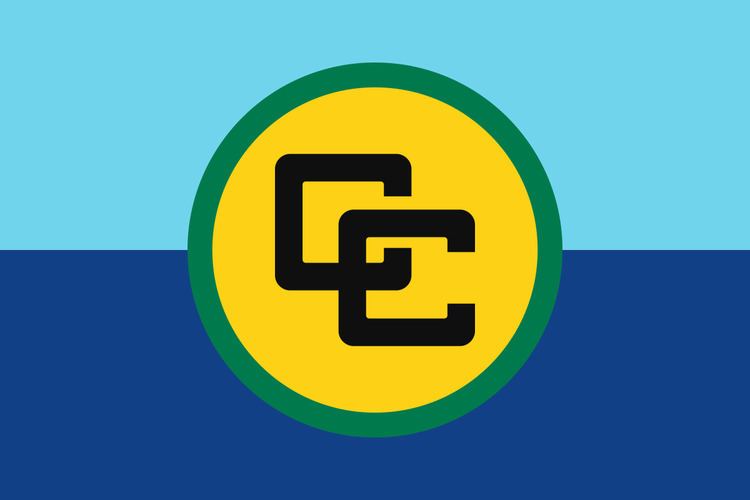 | ||
The Caribbean Free Trade Association (CARIFTA) was organised to provide a continued economic linkage between the English-speaking countries of the Caribbean following the dissolution of the West Indies Federation which lasted from January 3, 1958 to May 31, 1962.
Contents
History
The origins of CARIFTA lay in a meeting on July 4, 1965 between the Prime Ministers of Barbados and British Guiana (Errol Barrow and Forbes Burnham respectively) to discuss the possibility of establishing a free trade area between the two territories, which at the time were moving towards independence from the United Kingdom. The discussions revolved around establish a free trade area between only those two countries initially and then extending it to the rest of the Caribbean when the other countries in the Commonwealth Caribbean were ready to join.
These bilateral discussions between Barrow and Burnham were later expanded to include V. C. Bird of Antigua and the three leaders ultimately signed the initial CARIFTA Agreement (the Agreement of Dickenson Bay in Antigua) on December 15, 1965. The original date envisioned for the Caribbean Free Trade Area to come into existence, according to the Dickenson Bay Agreement, was May 15, 1967. However, as a result of shuttle diplomacy engaged by Dr. Eric Williams, Prime Minister of Trinidad and Tobago, (through one of his ministers, Kamaluddin Mohammed) this was postponed as in order to allow Trinidad and Tobago to be included in the agreement and to generally make the agreement region-wide from the beginning. Dr. Williams had for years been advocating the establishment of a Caribbean Economic Community and was now fearful that Barbados, Antigua and Guyana were planning to form a free trade area between themselves to the exclusion of Trinidad and Tobago. The push to make the free trade area a region-initiative was successful and the issue was discussed at the fourth Conference of the Heads of Government of Commonwealth Caribbean Countries in Bridgetown, Barbados in October 1967. There it was resolved to introduce the free trade area by May 1, 1968 with the delegations of Montserrat and British Honduras (Belize) entering reservations to the conclusions of the resolution due to the constitutional status of their governments at the time. As a result of this a supplementary agreement to the original Carifta Agreement was signed in Georgetown, Guyana on March 15, 1968, and in St John’s, Antigua on March 18, 1968 with Carifta Day set for May 1, 1968.
The new CARIFTA agreement came into effect on May 1, 1968, with the participation of Antigua, Barbados, Trinidad and Tobago and Guyana. The original idea to permit all territories in the region to participate in the Association was achieved a few months later with the entry of Dominica, Grenada, St. Kitts/Nevis/Anguilla, Saint Lucia and St. Vincent in July and of Jamaica and Montserrat on August 1, 1968. British Honduras (Belize) became a member in May 1971 fDEFINITION of 'Caribbean Free Trade Association (CARIFTA)' The Caribbean Free Trade Association (CARIFTA) is a multilateral free-trade area composed of Caribbean nations and dependencies that existed during 1965 to 1972. Following the dissolution of the West Indian Federation, a political union in the region, CARIFTA was established in order to strengthen and encourage economic activity among its members primarily by removing tariffs and quotas on goods produced within the trade bloc.
Read more: Caribbean Free Trade Association (CARIFTA) http://www.investopedia.com/terms/c/caribbean-free-trade-association-carifta.asp#ixzz4aDzA6tsW Follow us: Investopedia on Facebook following its government's agreement to become a member of the Association (and had promised to take the necessary steps to become so) in February 1969 at a Commonwealth Caribbean Heads of Government Conference in Port-of-Spain, Trinidad and Tobago.
Function
The Caribbean Free Trade Association was created to improve relations between the various Caribbean islands. One of the reasons of the formation of the CARIFTA was to increase the quota and variety of goods able to be sold. Specifically, CARIFTA was intended to encourage balanced development of the Region by the following:
In addition to providing for free trade, the Agreement sought the following:
Although CARIFTA itself was limited to trade in goods, it freed approximately 90% of intra-regional trade in manufactured goods and instituted managed intra-regional trade in some agricultural products.
Transformation and legacy
In 1973, CARIFTA became superseded by the Caribbean Community (CARICOM) following a decision, at the Seventh Heads of Government Conference in October 1972, to transform CARIFTA into a Common Market and establish the Caribbean Community of which the Common Market would be an integral part. At the Eighth Heads of Government Conference in April 1973, the Georgetown Accord was adopted, which set out the details of how CARIFTA was to be replaced by CARICOM. The Treaty of Chaguaramas declared that CARIFTA would cease to exist on 1 May 1974 when the remaining CARIFTA members all acceded to CARICOM.
The regional co-operation under the CARIFTA agreement also led to the foundation of several common institutions. The Commonwealth Caribbean Regional Secretariat was set up in Georgetown (Guyana) and the Caribbean Development Bank was established in Bridgetown, Barbados.
One of the legacies of CARIFTA is an international youth athletics event for junior athletes from the member states started in 1972 by the association and inaugurated (and thought up) by Austin Sealy (then president of the Amateur Athletic Association of Barbados) to mark the transition from CARIFTA to CARICOM called the CARIFTA Games. In 1985, a similar set of games, The CARIFTA Aquatics Championships, started.
Membership
In 1965, on December 15, the CARIFTA was founded by 3 countries:
The following countries joined the agreement:
In the 1970s, around the time CARIFTA was being transformed into CARICOM the following country was granted Liaison Status/Observer Status in the Association:
